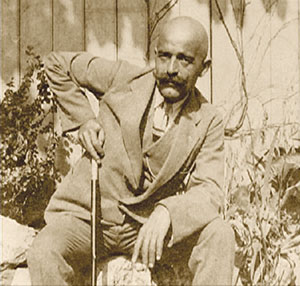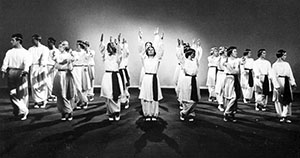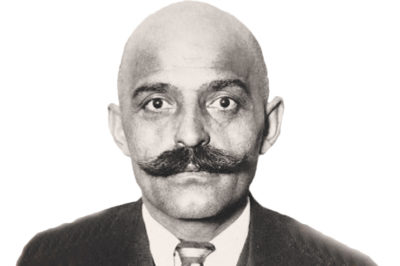This article was published in New Dawn 131 (Mar-Apr 2012)
It has happened to everyone. You go into a room only to find you have no recollection of why you went; someone reminds you of a promise you made but have completely forgotten; or you realise you’ve set down your keys but can’t remember where. Nor are such cases always matters of failure: sometimes you discover that you have done a perfectly good job of making coffee or writing a cheque even though you have no memory of it.
We usually take these harmless instances of forgetting for granted; it’s hard to believe that they can tell us anything important. But according to George Ivanovich Gurdjieff (1866?-1949), they point to the heart of the human predicament.
Long before the twentieth century’s discovery of the unconscious, people knew that there were unseen parts to themselves. “I cannot totally grasp all that I am,” wrote St. Augustine in the fifth century CE. “For that darkness is lamentable in which the possibilities in me are hidden from myself: so that my mind, questioning itself upon its own powers, feels that it cannot rightly trust its own report.”
Gurdjieff would have agreed. Indeed he insisted that we are not awake even in the so-called waking state, but go about our lives in a hypnotic stupor. “It may surprise you,” he said, “if I say that the chief feature of a modern man’s being which explains everything else that is lacking in him is sleep. A modern man lives in sleep, in sleep he is born and in sleep he dies” (emphasis here and in other quotes is in the original).
This sleep, Gurdjieff contended, is universal, or nearly so. Today some contend that the mass of humanity is being manipulated by a small and sinister elite who are keeping people in the dark in order to maintain their own power and position. This is not Gurdjieff’s view. According to him, the world’s leaders are in the same position as the rest of us. During World War I, Gurdjieff said, “Neither Emperor Wilhelm [of Germany], nor generals, nor ministers, nor parliaments, signify anything or can do anything.” Nor is it a matter of a secret cabal pulling the strings behind the scenes. Instead “everything that happens on a big scale is governed from outside, and governed either by accidental combinations of influences or by general cosmic laws.”

In 1915 in St. Petersburg, Gurdjieff met his most famous student, the man who, more than Gurdjieff himself, would become the most widely read exponent of his teaching: Piotr Demianovich Ouspensky (1878–1947). Ouspensky’s account of his experiences appears in what is perhaps the best and most famous book about Gurdjieff’s teaching: In Search of the Miraculous: Fragments of a Forgotten Teaching, which Gurdjieff himself endorsed as an accurate picture of his views. It presents an intricate and fantastic esoteric system. One theme is the “sleep” of ordinary life. Another is the disunity of the human being. Gurdjieff says:
Man such as we know him… cannot have a permanent and single I. His I changes as quickly as his thoughts, feelings, and moods, and he makes a profound mistake in considering himself always one and the same person; in reality he is always a different person, not the one he was a moment ago….
Each minute, each moment, man is saying or thinking “I.” And each time his I is different. Just now it was a thought, now it is a desire, now a sensation, now another thought, and so on, endlessly. Man is a plurality. Man’s name is legion.
Gurdjieff is here alluding to an ancient view of the human mind, which regards human beings as essentially tripartite, consisting of the intellect, the emotions, and the instinctive and motor functions of the body.
These three “centres,” as Gurdjieff called them, “instead of fusing inwardly in the normal way to produce common outer manifestations, have become, especially of late, quite independent outward functions…. [Man] cannot be master of himself, for not only does he not control these centres, which ought to function in complete subordination to his consciousness, but he does not even know which of his centres governs them all.”
This disjunction would be bad enough on its own, but it is compounded by “sleep,” the hypnotic trance in which we habitually live. Gurdjieff links this “sleep” to the concept of kundalini.
The spread of Eastern teachings over the past generation has made kundalini a comparatively familiar term. Most esotericists use this Sanskrit word to refer to the “serpent fire” at the base of the spine. This subtle energy is said to lie dormant in most people but can be awakened through meditation or yogic practices. Travelling up the spine, it brings about illumination when it reaches the head.
Gurdjieff thought this view of kundalini was completely wrong. “In reality Kundalini is the power of imagination, the power of fantasy, which takes the place of a real function. When a man dreams instead of acting, when his dreams take the place of reality,… it is the force of Kundalini acting in him. Kundalini can act in all centres and with its help all the centres can be satisfied with the imaginary instead of the real.”
In his immense and difficult magnum opus, Beelzebub’s Tales to His Grandson, Gurdjieff speaks of “the crystallised consequences of the properties of the organ kundabuffer.” Kundabuffer, a coinage of Gurdjieff’s, is a portmanteau word formed from “kundalini” and “buffer”; “buffers” were what he called those psychic mechanisms that keep the different “I” ’s from confronting each other. (The idea resembles the modern psychological concept of dissociation.)
But what Gurdjieff calls “the terror of the situation” is still worse. It might not matter if we lived our lives in sleep; perhaps we would not achieve all we could, but that almost inevitably happens anyway. According to conventional religion, if we are good, we will still go to heaven (or obtain a favourable rebirth) when we die.
Gurdjieff does not subscribe to conventional views of immortality. For Gurdjieff, we possess the possibility of having immortal souls, or what he calls “higher being-bodies,” but we almost never attain them because we live in sleep. And for undeveloped human beings, there is no immortality. “The ‘man-machine’… who is now one, the next moment another, the next moment a third, has no future of any kind; he is buried and that is all.”
This bleak view of human fate is reminiscent of the gloomier Gnostic cosmologies, and to many who have read In Search of the Miraculous, Gurdjieff sounds like a Gnostic. “Kundalini is a force put into men in order to keep them in their present state,” he asserts. “One would think that there are forces for whom it is useful and profitable to keep man in a hypnotic state.”

There is some truth to the idea that Gurdjieff is a kind of Gnostic, but only some. To understand it fully, we need to grasp something of his intricate cosmology. It can be best seen in a diagram known as the Ray of Creation (Figure 1). Gurdjieff did not claim to have originated it but said it “belongs to ancient knowledge.” Many other esoteric systems are, he adds, distorted or incomplete versions of this system.
As one can see from the diagram, the Ray of Creation rather resembles the way children sometimes address envelopes: after listing the street, city, and state, they will add “USA, North America, Planet Earth, the Solar System, the Milky Way, the Universe.” It also resembles the levels of manifestation seen in other systems, like the Kabbalistic Tree of Life. But Gurdjieff depicts the cosmic levels in terms of scale. The Absolute, or God, is all-encompassing. The next level is that of “all worlds,” that is, all galaxies (and perhaps all universes) taken as one. The next stage is that of “all suns” in our own galaxy, and so on. Each level, as it descends, is subject to a new set of cosmic laws of its own in addition to those of all the levels above it.
In contrast to the higher realms, where there is comparative freedom, we on Earth are subject to many cosmic laws. In fact we are very nearly at the bottom rung of the ladder – but not at the absolute bottom, for that rung is occupied by the Moon. Contrary to the prevailing scientific views both of his time and of our own, Gurdjieff held that the Moon is not cold and dead but is rather “an unborn planet, one that is, so to speak, being born. It is becoming warm gradually and in time (given a favourable development of the Ray of Creation) it will become like the Earth and have a satellite of its own.”
“Food for the Moon”

The growing Moon needs to be fed by certain cosmic energies. What Gurdjieff calls “a huge accumulator” exists on Earth to accomplish this end. This “accumulator” is organic life in all its forms: “Everything living sets free at its death a certain amount of the energy that has ‘animated’ it: this energy, or the ‘souls’ of everything living – plants, animals, people – is attracted to the Moon as though by a huge electromagnet.” Human beings, like the rest of life on Earth, are thus merely “food for the Moon.”
Such is the view set out in In Search of the Miraculous. Because this book is much more readable than Gurdjieff’s own magnum opus Beelzebub’s Tales to His Grandson, many take it as the final word. But Beelzebub amends this picture in an important way. For while Gurdjieff here reiterates that humanity was indeed designed as “food for the Moon,” he adds that we have a choice of how to serve this end.
Buried toward the end of Beelzebub, in a convoluted passage on war, Gurdjieff makes an important and often overlooked disclosure: that the energy needed to “feed the Moon” is precisely the same as that given off by people “forming and perfecting… their higher bodies by means of conscious labours and intentional sufferings.” If people do not serve the purposes of “Great Nature” by inner work, this energy will be extracted from them on a massive scale by means of wars and epidemics.
Gurdjieff’s picture of the universe, stated so baldly, seems improbable. What are we to make of “higher being-bodies,” “kundabuffer,” and the idea that we are “food for the Moon”? Does he mean these things literally? There was always a touch of the rogue about Gurdjieff, and the reader is sometimes struck by his writing in the same way that some people were struck by him in life: he seems to be staring at you with a penetrating gaze and asking you to decide whether or not he is kidding.
Yet there is nothing in Gurdjieff’s life and work to indicate that he did not mean what he said. He despised conventional wisdom, and indeed one of the main themes interwoven throughout Beelzebub’s 1,200 pages is that modern people are so stuffed with absurdities that they have lost sight of cosmic truths. So Gurdjieff would hardly be concerned that today’s scientists and psychologists might differ with many points of his teaching.
At the same time there is an elegance and sublimity to Gurdjieff’s vision. He is telling us not only that we are here for a purpose, but that the universe is benign and intricately constructed: if we fulfil its designs, we will be rewarded with immortality.
“The Fourth Way”
To rescue us from our plight, Gurdjieff brought what he called “the Fourth Way.” He contrasts his approach with three more familiar ways: (1) the way of the fakir, who masters his body to the point where he can stand “motionless in the same position for hours, days, months, or years”; (2) the way of the monk, who, by prayer and devotion to God, masters the emotions; (3) the way of the yogi, the one who gains control over the mind.
Unlike these paths, the Fourth Way, “the way of the sly man,” does not require withdrawal from the world, but can and should be pursued in the course of everyday life; and instead of working with the mind, the body, or the emotions alone, it works with all three. It is, Gurdjieff claimed, faster and more efficient than the other three ways. “The ‘sly man’ knows the secret,” said Gurdjieff, “and with its help outstrips the fakir, the monk, and the yogi.”
What is the sly man’s “secret”? It is a higher force, an energy that is able to penetrate the being of man and create unity in his centres where there was none before. This energy must come from above, but it will not come by itself; Gurdjieff does not preach quietism but advocates “conscious labours and intentional suffering.” (Indeed Gurdjieff’s disciples refer to his teaching as “the Work”; those attempting to follow it are said to be “in the Work.”) For a long time these “labours” and “sufferings” will consist, not in some sophisticated form of masochism, but in striving to overcome the slumber of daily life and see oneself as one really is.
A central practice of the Fourth Way is self-remembering. “You do not remember yourselves,” Gurdjieff chides Ouspensky’s Petersburg group. “You do not feel yourselves; you are not conscious of yourselves. With you, ‘it observes’ just as ‘it speaks,’ ‘it thinks,’ ‘it laughs.’ You do not feel: I observe, I notice, I see.”
Anyone who has read even a little in the literature of contemporary spirituality will find familiar resonances here, for many books emphasise the need for mindfulness. Gurdjieff’s teaching goes still further, for it puts this effort at the centre of the spiritual search. It also gives many more specific practices for “self-remembering”: people in the Work often receive instructions about being consciously present at certain moments of the day or during particular tasks.
Many who have read about – or even practiced – Gurdjieff’s teaching seem to fall into the trap of seeing “self-remembering” as a completely cerebral practice; trying to carry it out, they end up simply being self-conscious in the ordinary sense. They miss an essential part of the practice: that self-remembering entails a conscious effort of sensing the body.
Self-remembering begins with the body because, as the French Gurdjieffian Jean Vaysse puts it, the body “is solid and concrete, with an apparently stable form which can… be relied on to some degree. It is the instrument through which we perceive and our means of action. It can stay still voluntarily and thus is easier than the other parts for us to observe. It is relatively obedient, and we have a certain amount of control over it (in any case more than over our other parts). In addition, it is the one solid material base in us.”
Hence a Gurdjieffian reading this article might attempt to read while giving some attention to the sensation of some part of the body, the foot or hand, say, or even the body as a whole. This may sound simple, but if you try it, you’ll find it isn’t. If you’re lucky, you may be able to keep this “divided attention” for a few seconds before you lose it again. For a long time the Work involves returning to this sensation of the body over and over again no matter what you’re doing. Such attempts are known as “efforts.” They are meant to counteract the sleep of everyday life. Those who persist in this practice find that some of the “maleficent consequences of the properties of the organ kundabuffer” are, if not destroyed, at least interrupted, for these efforts help to dissipate daydreaming, absentmindedness, and the hazy stupor in which we stumble through our lives.
These efforts of attention tie into other aspects of the teaching as well. Gurdjieff defined attention as “the direction of the thinking centre’s activity.” Self-remembering, at least in the early stages, directs the “thinking centre” toward the body, which is governed by the “moving-instinctive centre.” Self-remembering brings these two centres closer together. When the mind is paying attention to the body, they are working a bit more in harmony, and the practitioner is slightly closer to becoming a unified being. (See the accompanying article on page 27 for further discussion – purchase a copy of the magazine to read it.)
Gurdjieff further explains that “making a conscious effort at the moment an impression is received” enables the organism to absorb more of certain subtle energies than it ordinarily does. These energies are used to create “higher being-bodies” that can withstand the shock of death. Thus self-remembering, a practice as rich and multileveled as meditation itself, is meant not only to counteract the sleep and disunity of man, but to help one attain the immortality that, Gurdjieff says, usually exists for us as nothing more than a possibility.

A second, closely related practice is self-observation, whereby one tries to see as much as possible of one’s own immediate state – thoughts, moods, emotions, reactions, and physical postures. Self-observation attempts to fulfil the injunction of the ancient oracle at Delphi: “Know thyself.” All true teachings must work toward this goal in some way. The Gurdjieffian technique is to observe ourselves in the course of daily life, to see ourselves as others see us, in all our moments of awkwardness, irrationality, and sleep.
This process not only helps students accumulate material for understanding themselves better, including the subtle organism of the “centres,” but it enacts certain changes in its own right. “Many psychic processes can take place only in the dark,” says Gurdjieff. “Even a feeble light of consciousness is enough to change completely the character of a process, while it makes many of them altogether impossible.”
Today most Gurdjieffian groups focus on the practices of self-remembering and self-observation; people also take part in various forms of physical labour and craftwork as a means of seeing different aspects of themselves. There are even some who continue an interesting facet of his teaching known as the Gurdjieff Movements.
The origins of the Movements form part of Gurdjieff’s legend, for most people in the Work connect them with the “sacred dances” he learned in his explorations in Central Asia during his youth. These dances, which Gurdjieff claims are over 4,500 years old, “correspond precisely to our books. Just as is now done on paper, so, once, certain information about long past events was recorded in dances and transmitted from century to century to people of subsequent generations.” Each posture forms a letter in an alphabet of gestures; understanding this code, you can read the information therein.

Although the Movements, accompanied by music written by Gurdjieff and his pupil, the composer Thomas de Hartmann, are still taught in some Gurdjieffian schools, it is not clear that the means of “reading” them has been passed down as well. If Gurdjieff did impart the secret to some of his pupils, it has been well hidden. It is rarely possible even to see a performance of the Movements; the best way of glimpsing them is in the 1977 film Meetings with Remarkable Men, directed by Peter Brook under the supervision of Gurdjieff’s pupil Jeanne de Salzmann, which shows the performance of some of these dances toward the end.
Anyone who does see the Movements can understand how they fit in with Gurdjieff’s teaching. They require the performer to maintain two or three different rhythms with different parts of the body, say, the head, arms, and feet, often while executing complicated dance steps. The difficulty of these “sacred dances” is obvious, but they accord with Gurdjieff’s goal of integrating the “three centres” so that a new, higher “I” can be created. As for the difficulty, Gurdjieff insisted that “only super-efforts count.”
What possibilities does the Work offer for the seeker today? Its hardships rarely take the peculiar forms they did under Gurdjieff himself, but much of the master’s rigor remains. It is not a path for those who crave conviviality or emotional warmth; many who encounter the Work complain of its coldness. On the other hand, this very characteristic tends to weed out dilettantes, so the calibre of people one encounters is probably higher than in many traditions. There are of course dubious entities that lay claim to Gurdjieff’s heritage, but most of them can be avoided if one keeps clear of groups that aggressively proselytise or demand exorbitant sums of money.
For a sense of the possibilities offered by the Gurdjieff Work, one might take a clue from Beelzebub, whose hero at one point remarks that of all the creatures in our solar system, “personally I liked best of all the three-brained beings breeding on the planet bearing the name Saturn.” Traditional astrology portrays Saturn as the cold, remote planet that creeps slowly through the sky. As such, it has always been associated with slow, unstinting labour (which is why in the old rhyme “Saturday’s child works hard for a living”) as well as with authority and depth. Hence the “super-efforts” required by the Work may seem to lack glamour and fun, but they may also confer knowledge that cannot be won by easier means.
© New Dawn Magazine and the respective author.
For our reproduction notice, click here.


